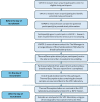Development and validation of a diagnostic prediction model for pancreatic ductal adenocarcinoma: VAPOR 1, protocol for a prospective multicentre case-control study
- PMID: 40866056
- PMCID: PMC12406849
- DOI: 10.1136/bmjopen-2024-094505
Development and validation of a diagnostic prediction model for pancreatic ductal adenocarcinoma: VAPOR 1, protocol for a prospective multicentre case-control study
Abstract
Introduction: Pancreatic ductal adenocarcinoma (PDAC) continues to have extremely poor patient outcomes, unlike other cancer types which have seen significant improvements in their treatments and survival. A major contributing factor is that PDAC is often detected at an advanced, incurable stage. In the UK, nearly half of patients have stage 4 disease at the time of diagnosis, which has a profound effect on treatment options and, ultimately, survival. To address the challenge of early detection of PDAC, this study aims to develop and validate a clinical prediction model based on a non-invasive breath test. The proposed breath test aims to assist general practitioners in the triaging of patients who present with symptoms that do not meet current criteria for urgent suspected PDAC pathway referral.
Methods and analysis: The Volatile organic compound Assessment in Pancreatic ductal adenOcaRcinoma (VAPOR 1) study is a prospective, multicentre, case-control study that aims to recruit 771 participants from England, Wales and Scotland. These include adult participants, aged ≥18 years, in three cohorts: pancreatic ductal adenocarcinoma; benign pancreatic controls (chronic pancreatitis or new-onset diabetes); healthy controls with a normal pancreas on imaging. A one-off breath sample will be obtained from participants who have fasted for at least 6 hours, and participant demographics and clinical data will be recorded. Breath samples will be analysed using gas chromatography-mass spectrometry to identify the volatile organic compounds (VOCs) present. Relationships between VOCs of interest and the presence of PDAC will be explored, and a clinical prediction model will be developed using statistical and machine learning methods and internally validated.
Ethics and dissemination: The VAPOR 1 study has received approval from the South East Scotland Research Ethics Committee 02, and from the Health Research Authority and Health and Care Research Wales (REC 22/SS/0061). Results of this study will be published in open-access peer-reviewed journals, and disseminated through pancreatic cancer conference presentations. In addition, lay summaries shared on our website, social media platforms and through our charitable funder, Pancreatic Cancer UK, will enable engagement with patients and the wider public.
Trial registration number: NCT05727020.
Keywords: Case-Control Studies; Clinical Decision-Making; Gastrointestinal tumours; Pancreatic disease; Pancreatic surgery; Triage.
© Author(s) (or their employer(s)) 2025. Re-use permitted under CC BY. Published by BMJ Group.
Conflict of interest statement
Competing interests: GBH is founder of a cancer diagnostic company. AP is technical manager at a cancer diagnostic company. GBH and PRB are named on patents related to volatile biomarkers. CC volunteered as a patient expert and PPI Representative for Pancreatic Cancer UK. The remaining authors disclose no conflicts.
Figures
References
-
- Vos T, Abajobir AA, Abate KH, et al. Global, regional, and national incidence, prevalence, and years lived with disability for 328 diseases and injuries for 195 countries, 1990–2016: a systematic analysis for the Global Burden of Disease Study 2016. The Lancet. 2017;390:1211–59. doi: 10.1016/S0140-6736(17)32154-2. - DOI - PMC - PubMed
-
- Cancer Research UK Pancreatic cancer statistics. [13-Mar-2024]. https://www.cancerresearchuk.org/health-professional/cancer-statistics/s... Available. Accessed.
Publication types
MeSH terms
Substances
Associated data
LinkOut - more resources
Full Text Sources
Medical

